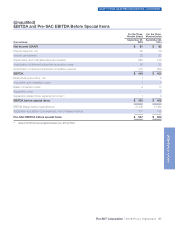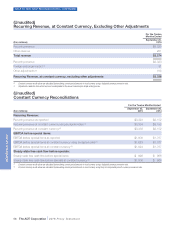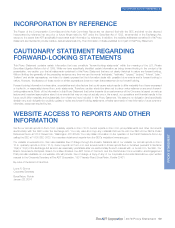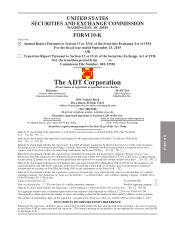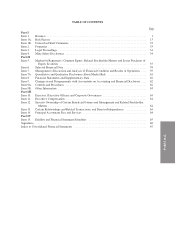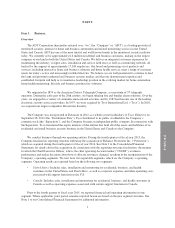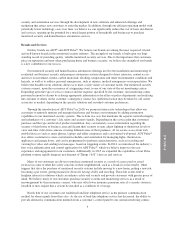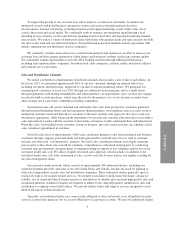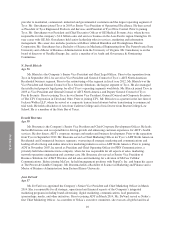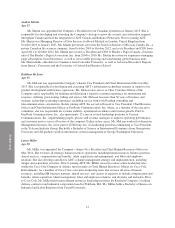ADT 2015 Annual Report Download - page 77
Download and view the complete annual report
Please find page 77 of the 2015 ADT annual report below. You can navigate through the pages in the report by either clicking on the pages listed below, or by using the keyword search tool below to find specific information within the annual report.
FORM 10-K
security and automation services through the development of new solutions and enhanced offerings and
marketing that attract new customers to enter the market. In addition, through our efficient operating model with
potentially lower technology costs over time, we believe we can significantly reduce the cost of basic installation
and services, opening up the potential for a much larger portion of households and businesses to purchase
monitored security and home/business automation services.
Brands and Services
Our key brands are ADT®and ADT Pulse®. We believe our brands are among the most respected, trusted
and well-known brands in the monitored security industry. The strength of our brands is built upon our long-
standing record of providing quality, reliable monitored security services. Due to the importance that customers
place on reputation and trust when purchasing home and business security, we believe the strength of our brands
is a key contributor to our success.
Our monitored security and home/business automation offerings involve the installation and monitoring of
residential and business security and premises automation systems designed to detect intrusion, control access
and react to movement, smoke, carbon monoxide, flooding, temperature and other environmental conditions and
hazards, as well as to address personal emergencies, such as injuries, medical emergencies or incapacitation. We
believe the breadth of our solutions allows us to meet a wide variety of customer needs. Our monitored security
systems connect, upon the occurrence of a triggering event, to one of our state-of-the-art monitoring centers.
Depending upon the type of service contract and the response specified by the customer, our monitoring center
personnel respond to alarms by relaying appropriate information to local fire or police departments and notifying
the customer or others on the customer’s emergency contact list. Additional action may be taken by call center
associates as needed, depending on the specific situation and recorded customer preferences.
Through the introduction of ADT Pulse®in 2010, we pioneered interactive technologies that allow our
customers to remotely monitor and manage their home and business environments by adding automation
capabilities to our monitored security systems. This is done in a way that maintains the separate network integrity
and redundancy of a customer’s life safety and security signals. Depending on the service plan that customers
purchase and the type and level of product installation, they can remotely access information regarding the
security of their home or business, arm and disarm their security system, adjust lighting or thermostat levels or
view real-time video from cameras covering different areas of their premises, all via secure access from web-
enabled devices (such as smart phones, laptops and tablet computers) and a customized web portal. ADT Pulse®
also allows customers to create customized schedules and automation for managing lights, thermostats,
appliances and garage doors, and can be programmed to perform certain functions, such as recording and
viewing live video and sending text messages, based on triggering events. In 2014, we introduced the industry’s
first voice authentication and control application for ADT Pulse®, which we believe improves the user
experience and engagement for our customers. Additionally, in 2015 we expanded the capabilities of our Pulse
platform to more rapidly integrate new Internet of Things (“IoT”) devices and services.
Many of our customers are driven to purchase monitored security as a result of a perceived or actual
increase in crime or other life safety concerns in their neighborhood, such as a break-in or fire nearby. Other
triggers that drive the purchase of monitored security systems include moving to a new home, getting a new job,
becoming a pet owner, getting married or divorced, having a baby and traveling. These life events tend to
heighten interest in solutions which can enhance safety and security and provide customers with greater peace of
mind. We believe many of our customers purchase security systems and monitoring services as a result of
encouragement by their insurance carriers, who may offer lower insurance premium rates if a security system is
installed or may require that a system be installed as a condition of coverage.
Nearly half of our customers use traditional land-line telephone service as the primary communication
method for alarm signals from their sites. As the use of land-line telephone service has decreased, the ability to
provide alternative communication methods from a customer’s control panel to our central monitoring centers
3


